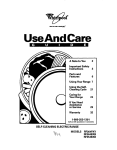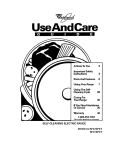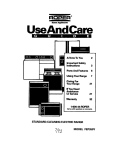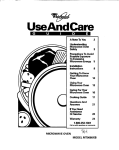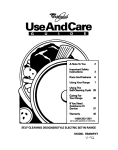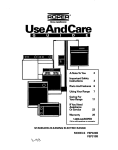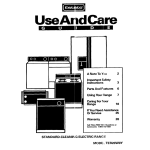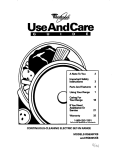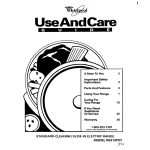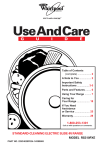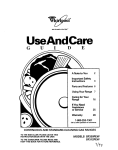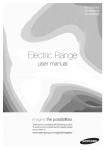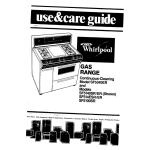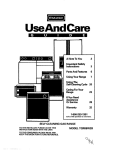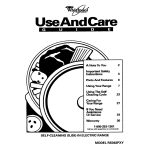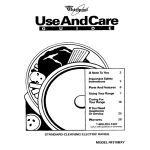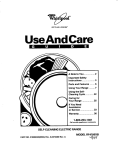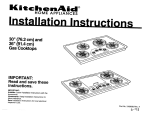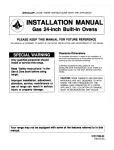Download Whirlpool RS3025XB User's Manual
Transcript
How To Meke A Home Rumn UseAndCare Tableof Contents 2 A Note to You 2 kiii!Ei:““’ 3 Parts and Features 6 Using Your Range 7 Catin for Your ia nge 18 If YQUNeed I tzk?!!e: 25 Wamnty 28 1400-253-1301 cdluswilhqlesthsorcomments. STANDARD-CLEANING ELECTRIC SLIDE-IN RANGES MODELS RS3025XB RS31OPXB PART NO. 229C4020P024/4399350 Table of Contents Page 2 A Note to You ............................................. ................... .3 Important Safety lnstwctions Parts and Features ..................................... 6 7 Using Your Range ...................................... Using the surface units .......................... 7 Positioning racks and pans ................... .9 For best air circulation ........................ .I0 Using aluminum foil for baking ............ .I0 Setting the clock .................................. 11 Using the Minute Timer ....................... 11 Baking/roasting ................................... 12 Adjusting the oven temperature control ............................. 13 14 Broiling ................................................ Page 15 Broiling tips .......................................... Energy saving tips ................................ 16 16 The oven vent ...................................... The storage drawer .............................. 17 The anti-tip bracket .............................. 17 Caring for Your Range .............................. 18 Surface units and reflector bowls ......... .I8 20 Lii-up cooktop ..................................... Removing the oven door ..................... .21 22 Cleaning chart ...................................... 24 The oven light ...................................... If You Need Assistance or Sewice.. ......... .25 28 Warranty ................................................... A Note to You Thank you for buying a Whirlpool@ appliance. Because your life is getting busier and more complicated, Whirlpool ranges are easy to use, save time, and help you manage your home better. To ensure that you enjoy years of troublefree operation, we developed this Use and Care Guide. It is full of valuable information about how to operate and maintain your appliance properly and safely. Please read it carefully. Also, please complete and mail in the Ownership Registration Card provided with your appliance. The card helps us to not’Hy you about any new information on your appliance. Please record your model’s information. Whenever you call our Consumer Assistance Center at l-800-253-1 301 or request service on your appliance, you need to know your complete model number and serial number. You can find this information on the model and serial number plate (see diagram on page 6 for location.of plate). Please also record the purchase date of your appliance and your dealer’s name, address and telephone number. Keep this book and the sales future reference. I 2 Model Number Serial Number Pure hase Date Dealer Name Dealer Address Dealer Phone slip together Our Consumer Assistance Center number is toll-free 24 hours a day. in a safe place 1-800-253-l for 301 1 safety Important Your safety is important Instructions to us. This guide contains safetv statements under warning symbols. Please-pay special attention to these symbols and follow any instructions given. Here is a brief explanation of the use of the symbol. This symbol alerts you to such dangers 1 t;gt3;;2;:, burns, fire and To reduce the risk of fire, electrical shock, injury to persons, or damage when using the range, follow basic precautions, including the following: General Read all instructions before using the range. 4nstall or locate the range only in accordance with the provided Installation Instructions. l l WARNING: To reduce the risk of ti ping of the appliance, the app Piance must be secured by a proper1 installed anti-tip bracket. f! o check if the bracket is installed properly, see “The anti-trp bracket on page 17. l CAUTION: Do not store things children mi ht want above the range. Chil %ren could be burned or injured while climbing on it. l Do not leave children alone or unattended in area where the range is in use. They should never be allowed to sit or stand on an part of the range. They could i e burned or injured. @Do not operate the range if it is damaged or not working properly. .Do not use the range for warming or heating the room. Persons could be burned or injured, or a fire could start. 4Jse the range only for its-in- . t;;;;i,use as described In this . continued on next page 1 .Do not touch surface units, areas near units, heating elements or interior surfaces of oven. Surface units and heating elements may be hot even though they are dark in color. Areas near surface units and interior surfaces of an oven become hot enou h to cause burns. During an cpafter use, do not touch, or let clothing or other flammable materials contact surface units, areas near units, heatin elements or interior surfaces 09 oven until they have had sufficient time to cool. Other surfaces of the range, such as the oven vent opening, the surface near the vent opening, the cooktop, and the oven door, could also i;;;pe hot enough to cause . @Do not wear loose or hanging garments when using the range. They could ignite if they touch a hot surface unit and you could be burned. *Use only d potholders. Moist or damp por holders on hot surfaces could result in burns from steam. Do not let potholder touch hot heating elements. Do not use a towel 4 or bulk cloth for a potholder. It coul J catch on fire. *Keep range vents unobstructed. .Do not heat unopened containers. The could explode. The hot con Yents could cause burns and container particles could cause injury. @Donot store flammable materials on or near the range. The fumes could create an explosion and/or fire hazard. When usinn the cooktoD l Make sure the reflector bowls are in place during cooking. Cooking without reflector bowls could subject the wiring and components underneath them to damage. ADO not line reflector bowls with aluminum foil or other liners. Improper installation of these liners could result in a risk of electric shock or fire. *Select a pan with a flat bottom that is about the same size as the surface unit. If pan is smaller than the surface unit, some of the heatin @Check to be sure lass cooking utensils are sa$ e for use on the range. Only certain types of glass, glass-ceramic, ceramic, earthenware or other lazed utensils are suitable ?or cooktops without breaking due to the sudden change in temperature. @Never leave surface units unat- *Turn pan handles inward, but not over other surface units. This will help reduce the chance of burns, i niting of flammable materia 9 s, and spills due to bumping of the pan. When using the oven l Always position oven rack(s) in desired location while oven IS cool. If a rack must be removed while oven is hot, do not let potholder contact hot heating element in oven. @Use care when opening oven door. Let hot air or steam escape before removing or replacing food. Grease l Grease is flammable. Do not allow grease to collect around cooktop or in vents. Wipe spillovers immediately. tray. Fla’ming grease outside of an can be extin uished with Eaking soda or, iBavailable, a multipurpose dry chemical or foam-type extinguisher. Care and cleaning @Donot soak removable heating elements in water. The element will be damaged and shock or fire could result. *Do not clean door heat seal. It is essential for a ood seal. Care should be ta% en not to rub, damage or move the seal. Clean only parts recommended in this Use and Care Guide. @Donot repair or replace any part of the range unless specifically recommended in this manual. All other servicing should be referred to a qualified technician. @Disconnect the electrical supply before servicing the range. - SAVE THESE INSTRUCTIONS - Parts and Features This section contains captioned illustrations of your range. Use them to become familiar with the location and appearance of all parts and features. (Model RSBlOPXB shown) Anti-tip bracket (SW p. 17) - Plug-in surface unit with one-piece chrome reflector bowl 2 (see pp. 7,22) Control panel Broil element (not shown) ‘(SW pp. 12: 14,15) Bake element (SW p. 12) Model and serial number plate . Control SA$ctct t-y panel unit P- 7) Left front control knob (s- P- 7) 6 Oven vent (see p. 16) Manual oven light switch (SW p. 24) L&t rear control knob (s= P- 7) Oven selector (SW pp. 12, 14,22) FrfFeMnute . (SW p. 11) Oven temperature control knob (see pp. 12, 13, 14.22) Right rear I control knob (SW P- 7) Right f rdnt control knob (s- P- 7) - Using Your Range To obtain the best cooking results possible, you must operate your range properly. This section gives you important information for efficient and safe use of your range. Using the surface units Push in control knobs before turning them to a setting. You can set them anywhere between HI and OFF. Surface unit markers The solid dot in the surface unit marker shows which surface unit is turned on by that knob. Surface heating indicator light The SURFACE HEATING Indicator Light on the control panel will glow when a surface unit is turned on. Burn and Fire Hazard Be sure all control knobs are turned to OFF and all indicator lights are OFF when you are not cooking. Someone coukf be burned or a fire could start if a surface unit is accidentally left ON. I Until you get used to the settings, use the following as a guide. For best results, start cooking at the high setting; then turn the control knob down to continue cooking. SElTlNG HI RECOMMENDED USE *To start focds cooking. l TO bring liquids to boil. Medium-high @To hoM a rapid boil. ~TO fry chicken or pancakes OFor gravy, pudding and Medium (me OFF) icing. @To cook large amounts of vegetables. Medium-low @To keep food cooking after starting it on a higher setting. *To keep food warm until LO ready to serve. 7 Cookware l l l l l l -~ -- _-.---~~ tips Select a pan that is about the same size as the surface unit. NOTE: For best resutts and greater energy efficiency, use only flat-bottomed cookware that makes good contact with the surface units. Cookware with rounded, warped, ribbed (such as some porcelain enamelware) or dented bottoms could cause severe overheating, which damages the cookware and/or surface unit. You can, however, use the newer cookware available with slightly indented bottoms or very small expansion channels. This cookware is specially designed to provide the good contact needed for best cooking resufts. Also, woks, canners and teakettles with flat bottoms suitable for use on your cooktop are now available in most stores that sell housewares. The pan should have straight sides and a tight-fiiing lid. Choose medium to heavy gauge (thickness) pans that are fairly lightweight. The pan material (metal or glass) affects how fast heat transfers from the surface unit through the pan material and how evenly heat spreads over the pan bottom. Choose pans that provide the best cooking results. Handles should be made of sturdy, heatresistant material and be securely attached to the pan. l l Product Damage Hazard If a surface unit stays red for a long time, the bottom of the pan is not flat enough or is too small for the surface unit. Prolonged usage of incorrect utensils for long periods of time could result in damage to the surface unit, cooktop, wiring and surrounding areas. To prevent damage, use correct utensils, start cooking on HI and turn control down to continue cooking. Do not leave an empty utensil, or one which has boiled dry, on a hot surface unit. The utensil coukf overheat and could damage the utensil or surface unit. Home canning information The large diameter of most water-bath or pressure canners combined with high heat settings for long periods of time can shorten the life of regular surface units and cause damage to the cooktop. To protect your range: l Use flat-bottomed canners/pans for best results. l Use the largest surface unit for best results. Also, use a canner/pan which can be centered over the surface unit and which does not extend more than one inch outside surface unit area. Large diameter canners/pans, if not properly centered, trap heat and can cause damage to the cooktop. l Do not place canner on two surface units at the same time. Too much heat will build up and will damage the cooktop. l Start with hot water. This reduces the time the control is set on high. Reduce heat setting to lowest position needed to keep water boiling. l Keep reflector bowls clean for best heat reflection. l To prolong the life of the elements: - Prepare small batches at a time. - Do not use elements for canning all day. l Refer to your canner manual for specific instructions. - Positioning racks and pans For baking/roasting with one rack, place the rack so the top of the food will be centered in the oven. Rack placement for specific foods: FOOD RACK POSITION Frozen pies, large roasts, turkeys Lowest level or 2nd level from bottom Angel and bundt cakes, most quick breads, yeast breads, casseroles, meats 2nd level from bottom Cookies, biscuits, muffins, cakes, nonfrozen pies 2nd or 3rd level from bottom Personal Injury Hazard *Always position oven rack(s) in desired location before turning oven on. Be sure the rack(s) is level. l If rack(s) must be moved while oven is hot, use potholders or oven mitts to protect hands. Failure to follow the above precautions could result in personal injury. When baking on two racks, arrange racks on bottom and third level from bottom. NOTE: For recommended rack placement when broiling, see “Broiling rack position chart” on page 15. To remove racks: 1. Pull rack toward you. 2. Tilt up front end. 3. Pull rack out. To replace racks: 1. Place rack on rack guides. 2. Tilt up front end. 3. Push rack in until it clears the stop. 4. Lower front and push rack in the rest of the way. 9 For best air circulation Hot air must circulate around the pans in the oven for even heat to reach all parts of the oven. This results in better baking. l Place the pans so that one is not directly over the other. l For best results, allow 1 ‘I$ to 2 inches (4.5 cm) of space around each pan and between pans and oven walls. There must be a minimum space of 1 inch (2.5 cm). l Use only one cookie sheet in the oven at one time. Use the following as a guide to determine where to place the pans: One pan Place in the center of the oven rack. Two pans Place in opposite comers of the oven rack. Three or four pans Place in opposite corners on each oven rack. Stagger pans so no pan is directly over another. Using aluminum foil for baking Use aluminum foil to catch spillovers from pies or casseroles: l Place the foil on the oven rack below the rack with the food. Turn up foil edges and make sure foil is about 1 inch (3 cm) larger all around than the dish holding the fcnxi. l Do not cover the entire rack with aluminum foil. It will reduce air circulation and cause poor cooking results. l Do not line oven bottom or entire oven rack with foil or other liners. Poor baking will result. Electrical Shock and Fire Hazard Do not allow foil to touch the heating elements. Failure to follow this precaution could result in electrical shock or fire hazard and damage to the elements. 10 Setting the clock 1. Press the Clock pad. 2. Press the Increase or Decrease pad until the correct time is displayed. Using the Minute Timer The Minute Timer does not start or stop the oven. It works like a kitchen timer. It can be set in hours and minutes up to 9 hours, 55 minutes. You can use the Minute Timer during any cooking function. 1. Press the Timer On/Off pad. 2. Press the Increase or Decrease pad until the desired time (in hours and minutes) is displayed. To cancel l the Minute Timer: When TIMER is on the Display, press the Timer On/Off pad. The time of day will show on the Display. 11 Baking/roasting 1. Position the rack(s) properly before turning on the oven. For further information see “Positioning racks and pans” on page 9. 2. Set the Oven Selector to BAKE. 3. Set the Oven Temperature Control Knob to the baking/roasting temperature you want. The OVEN HEATING Indicator Light will come on. The oven is preheated when the OVEN HEATING Indicator Light first goes off. NOTE: Do not preheat oven when roasting or cooking items such as casseroles. 4. Put food in the oven. During baking/ roasting, the elements will turn on and off to maintain the temperature setting. The OVEN HEATING Indicator Light will turn on and off with the elements. NOTE: The top element during baking/roasting, turn red. helps heat but does not 5. When baking/roasting is done, turn the Oven Selector to OFF. The OVEN HEATING Indicator Light will go off. 12 - -.- Adjusting ---.-- the oven temperature control Oven temperature controls will gradually shift after years of use. So, even though your new oven is properly adjusted to provide accurate temperatures, it may cook faster or slower than your old oven. If, after using the oven for a period of time, you are not satisfied with the temperature settings, you can change them by following these steps: 1. Make sure the Oven Temperature Control Knob is turned to the off position. Pull knob straight off and flip it over. 2. Loosen the locking screws inside the control knob. Note the position of the notches. Locking screws. 3. To lower the temperature, hoM knob handle firmly and move the tooth a notch counterclockwise. Each notch equals about 5°F (2.5%). 4. To raise the temperature, hold knob handle firmly and move the tooth a notch clockwise. Each notch equals about 5°F No&her To&h (2.5%). 5. Tighten the locking screws and replace the control knob. 13 Broiling 1. Position the rack properly before turning on the oven. The oven rack should be positioned so that the surface of the food is at least 3 inches (7 cm) away from the broil element. See “Broiling rack position chart” on page 15. 2. Put the broiler pan and food on the rack. 3. Close the door to the Broil Stop position (open about 4 inches [lo cm]). The door will stay open by itself. 4. Set the Oven Selector and Oven Temperature Control Knob to BROIL. The OVEN HEATING Indicator Light will come on. NOTE: Do not preheat oven when broiling. 5. When broiling is done, turn the Oven Selector to OFF. The OVEN HEATING lndiiator Light will go off. Custom broil If food is cooking too fast, turn the Oven Temperature Control Knob counterclockwise until the OVEN HEATING Indicator Light goes off. l If you want the food to broil slower from the start, set the Oven Temperature Control Knob between 170°F and 325°F (77% and 163°C). These temperature settings allow the broil heating element to cycle and to slow cooking. The lower the temperature, the slower the cooking. l Fish and chicken are some foods that may cook better if you use lower broiling temperatures. The Oven Selector must be on BROIL for all broiling temperatures. l NOTE: Leave the oven door partly open whenever using the oven to broil. This allows the oven to maintain proper temperatures. 14 Broiling rack RACK POSITION FROM BOllOM position chart MPE OF FOOD/ DONENESS Hamburger patties and thin steaks, l/i” thick or less Quickly searing food, rare and medium steaks, medium patties, ham slices, fish steaks, frankfurters 2 Well-done steaks and patties, lamb chops, split chicken, pork steaks and chops, whole fish 1 Not used for broiling Broiling l l e e e e tips Use the broiler pan and grid for broiling. They are designed to drain excess liquid and grease away from the cooking surface to help prevent spatter, smoke or fire. After brolllng, remove the broiler pan from the oven when you remove the food. Drippings will bake on the pan if you leave it in the heated oven. Fire Hazard Place meat the correct distance from the element. Meat placed too close to the element could spatter, smoke, burn or catch fire during broiling. @To ensure adequate grease drainage, do not use cookie sheets or similar pans for broiling. Also, covering the broiler grid with foil is not recommended. Poor drainage of grease could result in fire. lf foil is used, cut slits in foil to line up with all openings in broiler grid. Grease can then drain away and cool in pan. l 15 Energy saving tips Although the energy used for cooking is usually a very small percentage of the total energy used in the home, cooking energy can be used efficiently. Here are some tips to help you save energy when using your cooking product: l Use pans with flat bottoms, straight sides and tight-fiing lids. l Match the pan to the surface unit size. l Cook with a minimum of liquid or grease to help shorten cooking time. l Preheat pans only when recommended and for the shortest time possible. l Start food on higher heat settings, then set surface unit control on low or off to finish cooking. Use retained heat for cooking when possible. l Use the more efficient surface units instead of the oven when possible. l l l l l l l Turn on the surface unit only after placing filled pan on the unit. “Oven peeking” may cause heat loss, longer cooking times and unsatisfactory baking results. Rely on your timer to keep track of the cooking time. Bake cakes, pies or cookies when oven is warm. Best time to bake is right after a meal has been cooked in the oven. Preheat the oven no longer than necesWV. Plan your meals for the most efficient use of the range. When using the oven to cook one food, try to cook the rest of the meal in it also. Do not preheat when broiling, roasting or cooking items such as casseroles. Keep reflector bowls clean for best heat reflection. The oven vent Hot air and moisture escape from the oven through a vent under the right rear surface unit. You can cook on the unit or keep food warm on it while the oven is on. The vent is needed for air circulation. Do not block the vent. Poor baking/roasting can result. NOTE: Plastic utensils left over the vent can melt. l l 16 Bum and Fire Hazard If you leave a utensil on the right rear surface unit, use potholders when moving it. Pan handles could become hot enough to burn. Keep flammable materials away from oven vent. Failure to do so could result in burns or a fire. Oven vent The storage drawer You can remove the storage drawer to make it easier to clean under the range. Use care when handling the drawer. Removing the storage drawer: 1. Empty drawer before removing. Pull drawer straight out to the first stop. Lift front and pull out to the second stop. 2. Lift back slightly and slide drawer all the way out. Replacing the storage drawer: 1. Fit ends of drawer slide rails into the drawer guides on both sides of opening. 2. Lift drawer front and push in until metal stops on drawer slide rails clear white stops on drawer guides. Lift drawer front again to clear second stop and slide drawer closed. The anti-tip bracket The range will not tip during normal use. However, tipping can occur if you apply too much force or weight to the open door without the anti-tip bracket properly secured. Personal Injury Hazard .To reduce risk of range tipping over, secure range with a properly installed anti-tip bracket supplied with range. l If range is moved for cleaning or service, check that anti-tip device is engaged before using range. Failure to follow the above precautions could result in personal injury. To verify the anti-tip is engaged: l l bracket Grasp rear of range and carefully try to tilt forward. If anti-tip bracket is attached to floor or wall correctly, range should not tilt forward. See Installation Instructions for further details. Bracket optional location- ik / - Bracket factory location L---T>xy Washer and screw / Chain WI 1II I Mainback 17 Caring for Your Range Your range is designed for easy care. You can do most cleaning with items found around your home. Cleaning your range whenever spills or soiling occurs will help to keep it looking and operating like new. Surface units and reflector Removing 1. Make sure all surface units are off and cool before removing surface units and reflector bowls. 2. Lift the edge of the unit, opposite the receptacle, just enough to clear the reflector bowl. 3. Pull the surface unit straight away from the receptacle. 4. Lift out the reflector bowl. See ‘Cleaning chart” on page 22 for cleaning instructions. 18 Burn and Electrical Shock Hazard Make sure all controls are OFF and the range is cool before cleaning. Failure to do so could result in burns or electrical shock. bowls Replacing 1. Make sure all surface units are off and cool before replacing surface units and reflector bowls. 2. Line up openings in the reflector bowl with the surface unit receptacle. 3. Hold the surface unit as level as possible with the terminal just started into the receptacle. Push the surface unit terminal into the receptacle. 4. When terminal is pushed into the receptacle as far as it will go, push down the edge of the surface unit opposite the receptacle. NOTE: Reflector bowls reflect heat back to the utensils on the surface units. They also help catch spills. When they are kept clean, they reflect heat better and look new longer. If a reflector bowl gets discolored, some of your utensils may not be flat enough, or some may be too large for the surface unit. In either case, some of the heat that’s meant to go into or around a utensil goes down and heats the reflector bowl. This extra heat can discolor it. 19 Lift-up cooktop 1. Lift front of cooktop at both front corners until the support locks into place. Personal Injury Hazard Be sure support is fully extended and in the locked position. Failure to do so could result in personal injury from the cooktop accidentally falling. Product Damage Hazard Do not drop the cooktop. Damage could result to the porcelain and the cooktop frame. 2. Wipe with warm, soapy water. Use a soapy steel-wool pad on heavily soiled areas. 3. To lower the cooktop, lift cooktop from both sides while pressing the support back to unlock it. Lower the cooktop into place. 20 Removing the oven door Removing the oven door will help make it easier to clean the oven. Bum and Electrical Shock Hazard Make sure all controls are OFF and the oven is cool before removing oven door. Failure to do so could result in burns or electrical shock. 1. Open the door to the first stop position. 2. Hold the door at both sides and lift it at the same angle it is in. NOTE: Be careful not to place hands between the spring hinge and the oven frame as the spring hinge could snap back and pinch your fingers or damage the porcelain on the front of the range. Cover the hinges with toweling or empty paper towel rolls while working in the oven area. 3. To replace, fit the bottom corners of the door over the ends of the hinges. Push the door down evenly. The door will close only when it is on the hinges correctly. If hinges snap back against the oven frame, pull them back out. 21 - --- Cleaning - chart Use the following table to help you clean all parts of your range. PART. Control knobs WHAT TO USE Sponge and warm, soapy water HOW TO CLEAN l l l l Control Panel Sponge and warm, soapy water OR Paper towel and spray glass cleaner Exterior surfaces (other than control panels) Sponge and warm, soapy water l l l l l l l Turn knobs to OFF and pull straight away from control panel. Wash, rinse and dry thoroughly. Do not soak. Do not use steel wool or abraslve cleansers. They may damage the finish of the knobs. Replace knobs. Make sure all knobs point to OFF. Wash, rinse and dry thoroughly. Do not use steel wool or abrasive cleansers. They may damage the finish. Do not spray cleaner directly on panel. Apply cleaner to paper towel. Wash, rinse and dry thoroughly. Use nonabrasive, plastic scrubbing pad on heavily soiled areas. Do not use abrasive or harsh cleansers. They may damage the finish. On brushed chrome co&top, dry the surface following the “grain.” To help prevent finger marks after cleaning, spread a thin film of baby oil on the surface. Wipe away excess oil with a clean, soft cloth. NOTE: Do not allow foods containing acids (such as vinegar, tomato or lemon juice) to remain on surface. Acids may remove the glossy finish. Also wipe up milk or egg spills when cook-top is cool Surface units No cleaning required l l Chrome bowls 22 reflector Warm, soapy water and a nonabrasive, plastic scrubbing pad l l l Spatters or spills will burn off. Do not immerse in water. Wash, rinse and dry thoroughly. Clean frequently. Do not use abrasive or harsh cleansers. 3roiler pan rnd grid (clean sfter each use) Steel-wool pad and warm, soapy water 3ven racks Steel-wool pad and warm, soapy water 3ven door glass Paper towel and spray glass cleaner OR Warm, soapy water and a nonabrasive, plastic scrubbing pad Oven cavity HOW TO CLEAN WHAT TO USE PART Steel-wool pad and warm, soapy water l Wash, rinse and dry thoroughly. l Wash, rinse and dry thoroughly. Make sure oven is cool. Follow directions provided with the cleaner. Wash, rinse and dry thoroughly. l l l l l OR l Commercial cleaners oven l l l l l l Heavy-duty aluminum foil or shallow pan l Make sure oven is cool. Remove door for easier access. (See page 21.) Clean heavily soiled areas or stains. Rinse well with water. Remove door for easier access. Place newspaper on floor to protect floor surface. Follow directions provided with the oven cleaner. Rinse well with clear water. Use in well-ventilated room. Do not allow commercial oven cleaners tc contact the heating elements, heat seal, thermostat or exterior surfaces of the range. Damage will occur. Place piece of foil or shallow pan, slightly larger than the cooking container, on lower rack to catch spillovers. NOTE: Do not use foil or foil liner to cover the oven floor. Poor baking/roasting results could occur. 23 The oven light To turn the light on, use the Oven Light Switch on the control panel. Electrical Shock and Burn Hazard Make sure oven and light bulb are cool and power to the range has been turned OFF before replacing the light bulb. Failure to do so could resutt in electrical shock or burns. To replace the oven light: 1. Unplug appliance or disconnect power supply. at main 2. Remove the light bulb from its socket. Replace the bulb with a 40-watt appliance bulb. 3. Plug in appliance or reconnect main power supply. 24 at the If You Need Assistance or Service This section is designed to help you save the cost of a service call. Part 1 of this section outlines possible problems, their causes, and actions you can take to solve each problem. Parts 2 and 3 tell you what to do if you still need assistance or service. When calling our Consumer Assistance Center for help or calling for service, please provide a detailed description of the problem, your appliance’s complete model and serial numbers and the purchase date. (See page 2.) This information will help us respond properly to your request. 1. Before calling for assistance ... Performance problems often result from little things you can find and fix without tools of any kind. Please check the chart below for problems you can fix. It could save you the cost of a service call. PROBLEM Nothing operate will The oven will not operate The surface units will not operate Control knob(s) will not turn POSSIBLE CAUSE SOLUTION The unit is not wired into a live circuit with proper voltage. Wire the unit into a live circuit with proper voltage. (See Installation Instructions.) A household fuse has blown or a circuit breaker has tripped. Replace household fuse or reset circuit breaker. You have not turned the Oven Selector to BAKE or BROIL. Turn the Oven Selector to the desired setting. You have not turned the Oven Temperature Control Knob to a temperature setting. Turn the Oven Temperature Control Knob to a temperature setting. A household fuse has blown or a circuit breaker has tripped. Replace household fuse or reset circuit breaker. You have not plugged in surface units all the way. Turn control knobs to OFF and plug in surface units all the way. (See “Replacing” on page 19.) You are not setting the control knobs correctly. Push control knobs in before turning to a setting. You are not pushing in before turning. Push control knob(s) in before turning to a setting. continued on next page 25 -----._ - PROBLEM Cooking results are not what you expected 26 POSSIBLE CAUSE Level range. (See Installation Instructions.) The range is not level. The oven temperature too low or too high. SOLUTION seems Adjust the oven temperature control. (See “Adjusting the oven temperature control” on page 13.) You have not preheated the oven as the recipe calls for. Preheat oven if called for in recipe. The recipe has never been tested or is not from a reliable source. Use only tested recipes from a reliable source. The pans are not the type or size recommended in the recipe. Refer to a reliable cookbook for recommended pan type and size. There is not proper air circulation around pan when baking. Allow 1 l/i to 2 inches (4-5 cm) on all sides of the pans for air circulation. There must be a minimum space of 1 inch (2.5 cm). The cooking utensils are not the proper shape or do not fii the surface units being used. Use cooking utensils with smooth, flat bottoms that fii the surface units being used. 2. If you need assistance ... Call Whirlpool Consumer Assistance Center telephone number. Dial toll-free from anywhere in the U.S.A.: , 1-800-253-l 301 and talk with one of our trained consultants. The consultant can instruct you in how to obtain satisfactory operation from your appliance or, if service is necessary, recommend a qualified service company in your area. If you prefer, write to: Mr. William Clark Consumer Assistance Representative Whirlpool Corporation 2000 N State Route 63 Benton Harbor, Ml 49022-2692 Please include a daytime phone number in your correspondence. 3. If you need service 4. If you need FSP ment parts . . . FSP is a registered trademark of Whirlpool Corporation for quality parts. Look for this symbol of quality whenever you need a replacement part for your Whirlpool@ appliance. FSP replacement parts will ffl right and work right, because they are made to the same exacting specifications used to build every new Whirlpool appliance. To locate FSP replacement parts in your area, refer to Step 3 above or call the Whirlpool Consumer Assistance Center number in Step 2. 5. If you are not satisfied how the problem was solved . . . l ... Whirlpool has a nationwide network of authoSE!& rized Whirlpoor service 9 companies. Whirlpool service technicians are trained to fulfill the product warranty and provide after-warranty service, anywhere in the United States. To locate the authorized Whirlpool service company in your area, call our Consumer Assistance Center telephone number (see Step 2) or look in your telephone directory Yellow Pages under: -. . APPLlANcE-nousEHOLD YAJOFI, SERVICE L REPAJR - WAsHIN DRYERS, replace- l l with Contact the Major Appliance Consumer Action Panel (MACAP). MACAP is a group of independent consumer experts that voices consumer views at the highest levels of the major appliance industry. Contact MACAP only when the dealer, authorized servicer and Whirlpool have failed to resolve your problem. Major Appliance Consumer Action Panel 20 North Wacker Driie Chicago, IL 60606 MACAP will in turn inform us of your action. MACHINES k BENICE L REPAlR 27 WHIRLPOOL” Electric Range Warranty LENGTH OF WARRANTY WHIRLPOOL FULL ONE-YEAR WARRANTY From Date of Purchase FSP replacement parts and repair labor to correct defects in materials or workmanship. Service must be provided by an authorized Whirlpool service company. LIMITED WARRANTY FOR LIFE OF THE PRODUCT Second Year Through Life of Product From Date of Purchase FSP replacement WHIRLPOOL WILL PAY FOR parts for control knobs. WILL NOT PAY FOR A. Service calls to: 1. Correct the installation of your range. 2. Instruct you how to use your range. 3. Replace house fuses or correct house wiring. 4. Replace owner accessible light bulbs. B. Repairs when your range is used in other than normal, single-family household use. C. Pickup and delivery. Your range is designed to be repaired in the home. D. Damage to your range caused by accident, misuse, fire, flood, acts of God or use of products not approved by Whirlpool. E. Any labor costs during limited warranty. F. Repairs to parts or systems caused by unauthorized modifications made to the appliance. suet WHIRLPOOL CORPORATION SHALL NOT BE LIABLE FOR INCIDENTAL OR CONSEQUENTIAL DAMAGES. Some states do not allow the exclusion or limitation of incidental or consequential damages, so this limitation or exclusion may not apply to you. This warranty gives you specific legal rights, and you may also have other rights which vary from state to state. Outside the United States, a different warranty may apply. For details, please contact your authorized Whirlpool distributor or military exchange. If you need service, first see the “If You Need Assistance or Service” section of this book. After checking “If You Need Assistance or Service” additional help can be found by calling our Consumer Assistance Center telephone number, l-900-2581 301, from anywhere in the U.S.A. PART NO. 229C402OPO24/4389350 Printed In USA




























